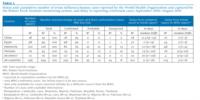
Introduction
Avian influenza (AI) has received public attention since 1997 when human infections and thereof six fatal cases due to the highly pathogenic avian influenza A(H5N1) virus strain were confirmed in Hong Kong [1,2] and the pandemic potential of AI viruses was recognised [3]. Since 2003, when avian influenza A(H5N1) reappeared, the World Health Organization (WHO) has reported 526 human infections with avian influenza A(H5N1), of which 311 were fatal, from Central Asian, European and African countries [4]. In several areas, highly pathogenic AI in poultry has become endemic - with implications on human health, as exposure to sick or dead poultry is a risk factor for AI in humans [2,5-8]. Because of the pandemic potential of avian influenza A(H5N1), there is a great need for joint risk assessments and as a prerequisite for rapid international sharing of biological materials, reference reagents, epidemiologic data and other information when available, e.g. between WHO member states and WHO [9].
Unique efforts were made to share information on AI infections in humans, domestic poultry and wild birds [10,11], e.g. through the reporting of confirmed human cases under the International Health Regulations (2005), supported by the WHO Global Alert and Response System (GAR) [12]. Case-based reports irrespective of the confirmation status have been mainly circulated by the Program for Monitoring Emerging Diseases of the International Society for Infectious Diseases (ProMED) [13]. News agencies such as Reuters Alertnet [14], and public health authorities, including the European Centre for Disease Prevention and Control (ECDC) [15], the World Organisation for Animal Health (OIE)/Food and Agriculture Organization (FAO) network on animal influenza (OFFLU) [16], and the Global Initiative on Sharing Avian Influenza Data (GISAID) [17], have contributed in compiling and publishing updates on AI in humans and birds online. However, a uniform, case-based and thus statistically analysable epidemiological database of all human AI cases is not yet publicly available.
Germany, in need for timely information on the AI situation when Europe faced first avian influenza A(H5N1) cases in birds in 2005, established an AI monitoring system at the Robert Koch Institute (RKI) in October 2005, which captures case-based information on AI infections in humans, as well as animal cases with zoonotic potential, worldwide. This system proved particularly useful for situation updates, risk assessments and national risk communication from February 2006 onwards, when avian influenza A(H5N1) was detected in wild birds in Germany [18]. Although the body of literature has continuously increased meanwhile, namely through WHO situation updates [2,19-23], and virological or epidemiological studies [5,24-27], the RKI AI monitoring system has been maintained to have a flexible database available for epidemiological evaluations.
With the aim to examine whether a systematic line list based on publicly available information on human AI cases would contribute to the understanding of the epidemiology of human AI, we assessed case characteristics, case fatality, and potential risk factors based on our established line list.
Methods
Monitoring system
The system established in October 2005, consists of a database, collecting events and reports in chronological order, and a line list of human cases. The present analysis is based exclusively on the line list and covers information on human AI cases reported between September 2006 and August 2010 and with a symptom onset date not earlier than September 2006. The monitoring followed a standardised operating procedure, defining information sources, intervals for screening the data and for the database management (as described below), and was maintained in Excel (version 11, Microsoft Corporation, Redmond, Washington, USA).
Information sources
All screened information sources for human AI cases were publicly accessible. They included WHO [12], ECDC [15], ProMED [13], as well as Reuters Alertnet [14].
This range of sources was accessed to anticipate the extent of non-confirmed human AI and to assess the loss of information when ignoring them. All sources were screened on a daily basis (weekdays only). If an event was reported simultaneously by more than one source, and if there was conflicting information, WHO reports were ranked highest, followed by ECDC and ProMED. If an event was reported prior to a WHO report by another source, both the WHO and the initial report were recorded.
Line list
The line list covered demographic case information, namely the country to which the cases were assigned to in the initial reports, the patients’ age (in years) and sex, date of symptom onset, date of hospitalisation, disease outcome, date of death, exposure to potentially infected poultry, as well as possible contact with infected individuals. Time intervals from symptom onset to hospitalisation, from hospital admission to outcome, the duration of hospitalisation, and the duration of illness were captured in days. The line list and a description of the variable set are provided online (http://www.rki.de/avian-influenza-linelist).
Case definitions
Cases were classified into three groups: confirmed cases, non-confirmed probable, and suspected cases, in a more simplified way than by WHO. Confirmed cases comprised avian influenza A(H5N1) human cases reported by WHO and with WHO confirmation, i.e. persons with defined clinical signs, epidemiological links and laboratory confirmation by an influenza laboratory accepted by WHO, as specified in the WHO case definition [28].
Other reported cases were (irrespective of their clinical presentation) considered as probable if they had exposure to WHO confirmed human cases, or to sick or dead poultry, or the AI virus infection was confirmed by the country or local institutions but not meeting WHO criteria. All other non-confirmed cases were defined as suspected cases.
Data analyses
The line list records were compared to the cumulative number of confirmed human cases of avian influenza A(H5N1) published by WHO [12]. The delay (in days) between the date of WHO reporting, and the date of the first report by another source than WHO, was calculated for WHO confirmed cases.
Confirmed cases were further analysed for demographic and epidemiological characteristics stratified by countries, including China, Egypt, Indonesia and Vietnam (with 10 or more cases) and a remaining group of all other countries. The cases were classified in age groups of 10 year intervals. Incidences were calculated over the study period as cases per 10 million population, using population data from the United Nations [29]. Median and inter-quartile ranges (IQRs) were calculated for continuous variables and absolute numbers and proportions (together with 95% exact confidence intervals (CIs)) for categorical variables. For comparison of characteristics, the Kruskal-Wallis test, the Wilcoxon-Mann-Whitney test and Fisher’s Exact test were used. Case fatality was assessed by calculating the cumulative (cCFR) and a rolling case fatality rate (rCFR). Investigated factors potentially associated with case fatality were age (grouped as 0–9, 10–19, 20–29, ≥30 years), sex, country, time from symptom onset to hospitalisation, and reported exposure to poultry. Univariable and multivariable logistic regression had been performed and results were presented as odds ratios (OR) with 95% confidence intervals. In multivariable analysis forward and backward selection was applied on all variables, where sex was taken into account in all calculations. All possible two-way interaction terms were tested separately and the likelihood ratio test was used to analyse whether interaction terms improved the model at a significance level of 10%. The reported p values are two sided and p<0.05 was considered statistically significant. Data were analysed using Excel (version 11, Microsoft Corporation, Redmond, Washington, USA) and Stata (version 11.0, StataCorp LP, TX, USA) software.
Results
Reported cases
In the study period, we captured 294 human AI cases in 12 different countries of which 235 (80%) were WHO confirmed, 35 (12%) were classified as probable, and 24 (8%) as suspected. The proportion of confirmed cases was highest in Egypt (98/99, 99%) and lowest in Indonesia (82/126, 65%). Numbers of reported WHO confirmed cases in our line list were largely congruent with cumulative case numbers published by WHO, except for Indonesia with 82 versus 102 cases, respectively (Table 1). This allowed for a close reproduction of WHO graphs on avian influenza A(H5N1) human cases by date of symptom onset and country, which reveal highest case numbers in the winter and spring season of the northern hemisphere (Figure 1).
Table 1. Status and cumulative number of avian influenza human cases reported by the World Health Organization and captured by the Robert Koch Institute monitoring system, and delay in reporting confirmed cases, September 2006–August 2010
Figure 1. Number of confirmed avian influenza A(H5N1) human cases by date of symptom onset and country, as well as cumulative case fatality rate and 19-months rolling case fatality rates, September 2006–August 2010 (n=213)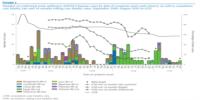
The median delay from symptom onset to the initial report by any source was 11 days among 201 cases with available information (Table 1). Egypt had the shortest median delay of seven days. Fifty-two percent of the confirmed cases (123/235) were initially reported by another source than WHO in a median of three days prior to the WHO report (Table 1). The shortest median delay between the initial report and the WHO report was two days in China and Indonesia, whereas the longest median delay was nine days in Vietnam and the grouped remaining countries.
Demographic characteristics
Fifty-seven percent of confirmed cases (132/233 with available information) were women and 43% (101/233) men corresponding to a men-to-women ratio of 0.8. This ratio ranged from 0.6 to 1.3, with 0.6 in Indonesia, 0.8 in Egypt, 1.0 in the grouped remaining countries, 1.1 in Vietnam, and 1.3 in China.
The cases’ median age was 18 years but was significantly higher in women than in men (21 years in women vs 14 years in men, p=0.04, Table 2). The median age differed markedly across countries. The lowest median age of six years was found in Egypt with significant difference between women and men (16.5 vs 4 years, respectively, p=0.002). In Egypt, the youngest age group (0 to 9 years) accounted for the highest number of cases with 53 of 98 cases (54%) and had the highest incidence of 284 cases per 10 million population of the same age group, over the four-year study period. In contrast, Indonesia, China, and Vietnam had highest case numbers and incidences in the age group of 20 to 29 years (Figure 2).
Table 2. Median age of confirmed avian influenza A(H5N1) human cases by outcome (surviving or fatal) and sex, stratified by country, September 2006–August 2010 (n=233) 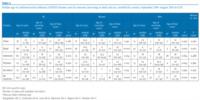
Figure 2. Incidences and number of confirmed avian influenza A(H5N1) human cases by age group and country, September 2006–August 2010 (n=230)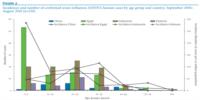
Exposure to poultry
Ninety-six percent of confirmed cases (187/194 with available information) had reportedly direct or indirect contact to potentially infected poultry. The proportion of individuals with reported exposure differed significantly across countries (p=0.009) and ranged from 80% to 100%, with 8/10 in the grouped remaining countries, 10/12 in China, 55/57 in Indonesia, 93/94 in Egypt and 21/21 in Vietnam without significant differences by the cases’ sex or age (p=0.70 and p=0.06, respectively).
Hospitalisation
All 228 cases with available information had been hospitalised. Patients were admitted to hospital in a median of four days after symptom onset (N=197, Table 3). The median time from symptom onset to hospitalisation ranged from two to five days, with two days in Egypt, two and a half days in the grouped remaining countries, four days in China and five days in Indonesia and Vietnam. No significant sex-specific differences were found in this delay (p=0.706).
Table 3. Time from symptom onset to hospitalisation or fatal outcome for confirmed avian influenza A(H5N1) human cases, stratified by country, September 2006–August 2010 (n=197)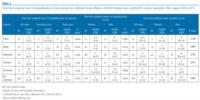
Case fatality
Fifty-six percent (132/235) of confirmed cases died. The CFR differed across countries ranging from 28% (27/98) in Egypt to 87% (71/82) in Indonesia. The cCFR and the 19-month rCFR indicated a decline in case fatality over the study period (Figure 1). Whereas the cCFR was little affected by the outcome of new cases and had only slightly decreased, the rCFR had steeply declined in the period from April 2008 to April 2009. Until mid 2008, a large proportion of cases occurred in Indonesia (country with highest CFR) and shifted thereafter to Egypt (country with lowest CFR). Accordingly, country-specific rCFRs for Indonesia and Egypt were less steep than the overall rCFR. The 19-months rCFR was privileged as it was less affected by case-free periods than rCFRs calculated over shorter periods (not shown).
In Egypt, fatal cases had a median age of 25 years, which was, at significant level, higher than the age of cases who survived (four years, p<0.001; Table 2). The CFR in Egypt was significantly higher in women than in men, (39% (22/56) vs 12% (5/42) respectively, p=0.003), which was not observed elsewhere (China: 63% (5/8) in women vs 70% (7/10) in men, p=1.0; Indonesia: 84% (43/51) vs 90% (28/31), p=0.521; Vietnam: 58% (7/12) vs 69% (9/13), p=0.688; remaining countries: 80% (4/5) vs 40% (2/5), p=0.524, respectively).
A significant difference in time from symptom onset to hospitalisation between survivors and fatal cases was only found in Egypt (one day vs four and a half days respectively, p=0.001, Table 3). All 19 cases worldwide hospitalised eight days after symptom onset or later had died.
Figure 3 shows the CFR in function of the time from symptom onset to hospitalisation, stratified by Egypt and Asian countries (grouped).
Figure 3. Time from confirmed avian influenza A(H5N1) human cases’ symptom onset to hospitalisation and case fatality rate stratified for Egypt and Asian countries, September 2006–August 2010 (n=197)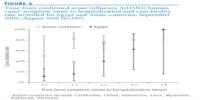
The median time from symptom onset to death was nine days (N=118), irrespective of the patients’ sex (p=0.605), and without significant difference across age groups (p=0.564, data not shown) or reporting countries (p=0.213).
The multivariable logistic regression revealed that odds of fatal outcome increased by 33% with each day that passed from symptom onset until hospitalisation (OR: 1.33, 95% CI: 1.11–1.60, p=0.002). In relation to children of 0–9 years, odds of fatal outcome were more than six times higher in 10–19 year-olds and 20–29 year-olds (OR: 6.06, 95% CI: 1.89–19.48, p=0.002 and OR: 6.16, 95% CI: 2.05–18.53, p=0.001, respectively), and nearly five times higher in patients of 30 years and older (OR: 4.71, 95% CI: 1.56–14.27, p=0.006). Using Indonesia as a reference, odds of dying were lower elsewhere, namely by 92% in Egypt (OR: 0.08, 95% CI: 0.03–0.22, p<0.001), by 81% in China (OR: 0.19, 95% CI: 0.04–0.90, p=0.036), and by 79% in Vietnam (OR: 0.21, 95% CI: 0.06–0.75, p=0.016), but not in the grouped remaining countries (OR: 0.23, 95% CI: 0.04–1.27, p=0.091). Exposure to poultry was not significant and none of the interaction terms significantly improved the model fit. They were thus not retained in the final model.
Discussion and conclusions
With this study, we summarised the current global AI situation in humans. It is, to our knowledge, the first study that not only analysed human AI cases worldwide on the basis of a line list collected over several years but in addition made these case-based data available online. We found that a longer delay from symptom onset to hospital admission and belonging to older age groups were associated with higher mortality in AI patients, and that the situation in Egypt differed markedly from other countries with highest AI incidences in children and lowest CFR.
With our line list, cumulative case numbers published by WHO [4] could be largely reproduced: 235 of 256 WHO confirmed cases (92%) and additional 59 unconfirmed cases were captured between September 2006 and August 2010. The identified median reporting delay of 11 days after symptom onset may partly be explained by a deferred presentation to healthcare facilities as well as by the time needed for pathogen confirmation. About 52% of confirmed cases had been reported elsewhere in a median of three days prior to the WHO report. Because delays in availability of information could hamper investigations of the source of infection and of clusters of human cases [30], it could be beneficial to report and document probable cases in parallel with confirmed ones [31].
Confirmed cases had a median age of 18 years, which is consistent with earlier findings, although investigation periods and affected countries varied [2,19,21]. The identified predominance of female cases in Indonesia and Egypt and the low age median among Egyptian cases support findings from previous studies [2,23-25]. Schroedl [32] examined the mean age of cases in Egypt over four seasons between August 2006 and July 2009 and found a declining age-based pattern over time, but did not address sex-specific differences. We found, in line with other studies, a significantly older age of female cases than male cases, whose proportion had increased since 2008 in Egypt [24,25]. Chen et al., analysing AI cases worldwide before June 2006, also identified sex-specific differences in the age-groups of 4 to 6 years (95% male) and 25 to 30 years (83% female) [33]. They assumed particularly high levels of exposure in pre-school boys playing outdoors and housewives taking care of fowl and frequenting live markets. Fasina et al. suggested a similar explanation for the situation in Egypt [25].
Ninety-six percent of the cases had reportedly direct or indirect contact to potentially infected poultry, recognised as the most important risk factor for humans AI [8,34]. The WHO Clinical Case summary Form [35], where e.g. “poultry” can be checked as “most likely source of infection” has enhanced the systematic collection of information since 2007. However, currently reported information yields little insights into the actual source of infection and the intensity and quality of exposure needed to infect humans [36-38].
The median time from symptom onset to hospitalisation was four days, which is remarkably stable when compared to earlier studies [19,21]. If time to hospital admission is regarded as an indicator for monitoring case management and patients’ awareness [31], no progress would be evident from a global perspective so far.
The cases’ average CFR was 56%, which is widely consistent with findings from earlier investigation periods [2,19,23]. Using a 19-month rolling CFR, we found a clear decrease in case fatality, which persisted when stratifying for Egypt and Indonesia. It could thus not simply be explained by a predominance of Egyptian cases since 2009. Regarding the decreasing CFR in Egypt, Schroedl [32] suggested that the circulating AI virus strain may have become less virulent and more apt to spreading among children.
Analytical results revealed lowest odds of dying for Egyptian cases, even when adjusted for age, sex and time to hospitalisation. Thus, the high proportion of survivors in Egypt cannot be entirely explained – as often assumed – by sex-specific differences in CFR [21,24] and the high proportion of children among AI patients in Egypt [5], as well as short delays from symptom onset to hospitalisation [25].
It cannot be ruled out, that different virus clades circulating in Egypt (clade 2.2) and Asia (clades 2.1 and 2.3) shape the country-specific epidemiological features [2,23]. Differences in CFR across countries and changes over time might also partly be explained by differences in intensity and quality of exposure, health-seeking behaviour, reporting attitudes, overall performance of the surveillance system, and access to diagnostics and medical care [23,27,39,40], such as the time to start of oseltamivir treatment, the antiviral recommend by WHO for human infections with AI virus [2]. However, country-specific details on its administration are widely unknown and it remains controversial up to how many days after symptom onset the application of the antiviral reduces mortality [30,41]. In our study all patients hospitalised eight or more days after symptom onset died. This suggests a rather narrow time window for antiviral drug administration.
Our study was solely based on data from publicly available case reports and is subject to several limitations. Our monitoring instrument was only entirely implemented in August 2006 and thus trend analyses were not exploited to its full extent. Within the used reports, negative values, e.g. “case not hospitalised”, were not systematically mentioned, which may lead to biases. Time specifications, e.g. on dates of exposure or hospitalisation, needed for time-to-event analyses, were often incomplete. Case reports did not systematically contain details on medical care and specific antiviral treatment. Therefore, analyses were restricted to “hospitalisation” as general indicator for access to medical care. Given the sparse information on possible contact with infected individuals and clusters of human AI cases available from the serial reports within the investigated period, clusters could not be evaluated as initially planned. Other studies reporting on clustered cases had mostly accessed additional case-investigation reports and patient interviews [23,30]. We based our analyses on WHO confirmed cases, although unconfirmed cases had been recorded in our line list, due to lacking information for probable and suspected cases. Including probable cases in our analyses did, however, not change the cases’ sex ratio or CFR substantially when compared to confirmed cases only.
Our study points out that data extracted from the public domain already yields pertinent epidemiological information for assessing the current situation and developments of AI in humans. A line list format as provided would enhance the analysability of key data, their updating, and the evaluation of variables needed. Several countries monitor the global AI situation, whether they currently face human AI cases, e.g. Egypt [25], or not, e.g. France [27]. This indicates a common interest in data and if they were directly provided in such format, this would help to save time and resources for public health authorities and researchers.
A line list needs to be flexible in view of potential new information to be entered. New variables and parameter values might come up, when the minimum dataset suggested Bird and Farrar [31] on direct and indirect exposures to avian influenza A(H5N1) confirmed and non-confirmed poultry and human exposures would be implemented or when results from prospective studies involving exposed and unexposed individuals as designed by Kayali et al. [34] are available. Unconfirmed cases would ideally be recorded as systematically as confirmed cases, either in a common or separate database as suggested by Bird and Farrar [31].
Presenting cases in the format of a line list is not a goal in itself, but a prerequisite for targeting surveillance and identifying risk factors, as well as a starting point for prospective studies, e.g. investigating potential human-to-human transmission, the transmissibility of avian influenza viruses, and host-related factors including age-dependent immunity in humans [33,42].
We would like to encourage that an anonymised case-based database for AI in humans is directly placed publicly and continuously updated, e.g. by an internationally renowned organisation such as WHO. Open access to analysable data might accelerate the identification and implementation of research questions and surveillance priorities and thus enhance our understanding of – still mostly fatal – AI in humans and permit the rapid detection of epidemiological changes with implications for human health.
Acknowledgements
The authors would like to thank Matthias an der Heiden for statistical support in an early stage of the analysis. Matthias an der Heiden, Bonita Brodhun, Christian Braun, Wei Cai, Frank Gerlach, Karla K?pke, Carmen Kresse, Tina Paul, Daniel Sagebiel, Petra St?cker, Alexander Stinzing, Thorsten Sü?, Dirk Werber and Irina Zuschneid are acknowledged for maintaining the monitoring system.
References